Term 1 Chapter 4 | 3rd Science - Science in Everyday Life | 3rd Science : Term 1 Unit 4 : Science in Everyday Life
Chapter: 3rd Science : Term 1 Unit 4 : Science in Everyday Life
Science in Everyday Life
Unit 4
Science in Everyday Life

Learning Objectives
After learning this lesson, students will be able to
* apply the knowledge of scientific principles in day-to-day life
* observe the science that works in the kitchen
* learn about the value of cooking items and their medicinal properties
* explore scientific investigations in everyday life
* measure the boiling point of water and milk
Introduction
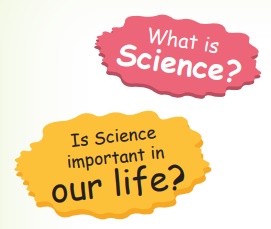
Do you think science is separable from our day to day life?
Science is the study of the natural world around us. We learn science by observing, experimenting and describing.
Science is all around us. Examples of science can be observed from the time we wake up till we go to sleep and even while one is sleeping.
Science influences most aspects of everyday life, including food, energy, medicine, transportation and leisure activities.
How science is involved in daily life?
* Even in our sleep our body is working continuously. We also see dreams in our sleep.
* When we eat food, our digestive system is at work.
* Medicine, vessels and furniture we use are the products of science.
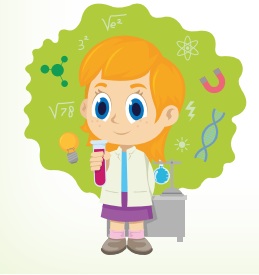
1. KITCHEN SCIENCE
If one wants to explore science in its everyday use, then kitchen is the right place to start.
![]() To understand how water boils or how idlis are made, we need to know science.
To understand how water boils or how idlis are made, we need to know science.
Boiling Water
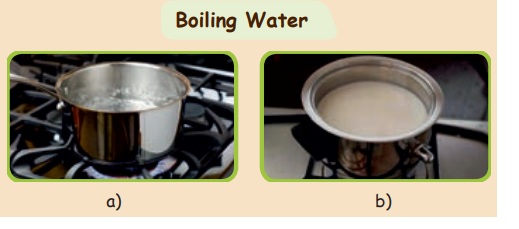
What do you infer from the above pictures?
The first picture shows boiling water and the second shows boiling milk.
What is boiling?
Heating a liquid until it becomes gas is called boiling. Boiling the water means to heat the water until it becomes gas and mixes with the air.
Boiling Point
The boiling point of a substance is the temperature at which the liquid boils. At this temperature, the liquid changes into gas.
Benefits of boiling water
* Destroys germs
* Improves digestion
* Prevents us from the infection of waterborne diseases
Cooking Idli
Idli is a common and usual breakfast of Tamil Nadu.
* What process is involved in the preparation of idli batter?
* What type of cooking process is involved in making idli?

Do you know the ingredients used for making idli?
1. Rice (Boiled rice)
2. Black gram (Black Lentils)
3. Fenugreek (Vendayam) and
4. Salt
Idli batter produced from above things is fermented for 8 hours before use.
Idli is cooked by the method called Steaming.
Idli is prepared using idli cooker.
Idli Making
1. Soaking rice and blackgram in water
2. Grinding
3. Allowing it to ferment
4. Steaming in idli cooker

Advantages of Steaming
* Easy cooking method.
* Steamed food is easily digested.
* Steamed food retains Vitamin C and E.
Idiyappam
We cook idiyappam by steaming. Idiyappam is prepared from rice.
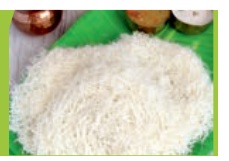
Let us Taste - Varieties of Idlies
In order to attract the children and customers, caterers make varieties of idli by mixing the batter with beetroot grate or carrot grate and serve them as beetroot idli or carrot idli.

Let us think
The doctor advices patients to have idli or idiyappam. Can you guess why?
* Idli is cooked by steaming.
* Steamed food is easily digested.
Tick (✓) the item which you see in your kitchen.

Tick (✓) the food items which are made by steaming.

Arrange the pictures in correct order.
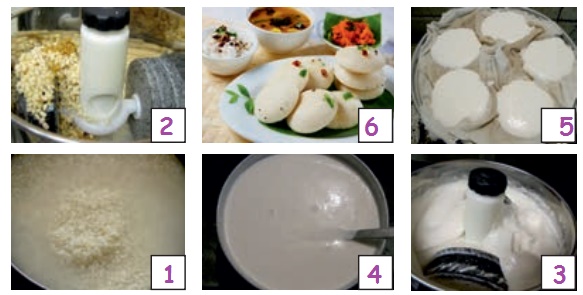
2. Home appliances - Pressure Cooker
How would our life be without the following?
1. A light bulb - ____________
2. A fan - ________________
Things like light bulb and fan are called home appliances.
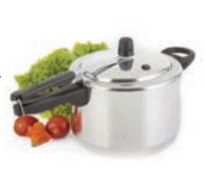
It is not easy to run our life these days without home appliances. Home appliances are machines that make life a lot easier and convenient. In this section, we will learn about a few such appliances.
* Look at the picture and name it.
* Can you list the uses of pressure cooker?
Cooking food using water in a sealed vessel (cooker) is called pressure cooking.
Benefits of Pressure Cooker

Saves time
Minimizes the usage of fuel and saves energy
Retains nutrients in food
Preserves the appearance of food
Do you know : Pressure-cooking can cook foods four times faster than ordinary cooking.
Let us Discuss
1. Which one takes less time to cook pulses?
Answer : a. pressure cooker
2. List out the food items prepared by using pressure cooker. Discuss with your friends.
Pulses, Rice, Idli, Briyani.
3. Other Home Appliances
Let us learn about some common home appliances and their uses .
Common Home Appliances and their Uses
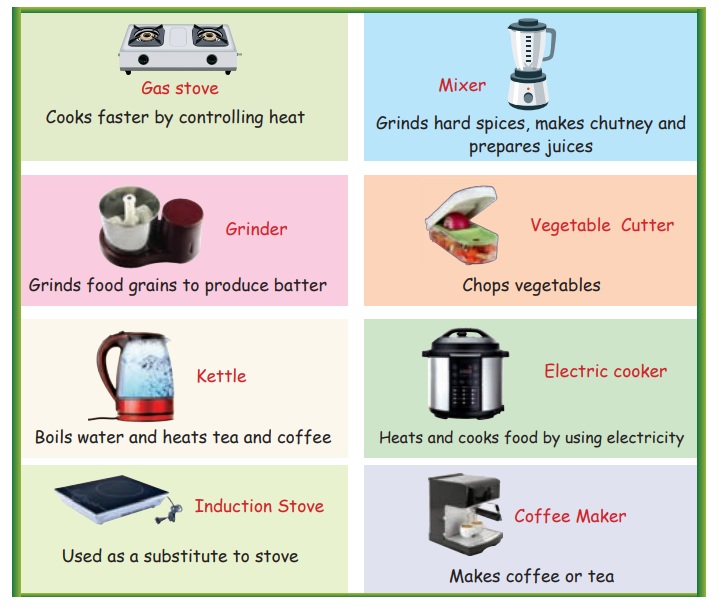
Gas stove: Cooks faster by controlling heat
Mixer: Grinds hard spices, makes chutney and prepares juices
Grinder: Grinds food grains to produce batter
Vegetable Cutter: Chops vegetables
Kettle: Boils water and heats tea and coffee
Electric cooker: Heats and cooks food by using electricity
Induction Stove: Used as a substitute to stove
Coffee Maker: Makes coffee or tea
A Refrigerator (Fridge) is a popular home appliance for preserving food. It works on the principle of cooling.
The fridge has a pump that transfers heat from the inside of the fridge to its outside. This helps it to keep things cold.
The cold temperature inside the fridge slows down the bacterial growth in food and thus preserves the food for a longer time.
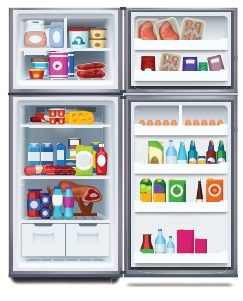
Safety Measures in Kitchen
* Never play with kitchen utensils such as knives, match boxes and glasswares.
* Use a cloth to hold hot pans.
* Inform an adult in case you smell cooking gas leakage
* Turn off the gas stove, microwave oven and any other electrical gadget immediately after use.
Match Column A with Column B.

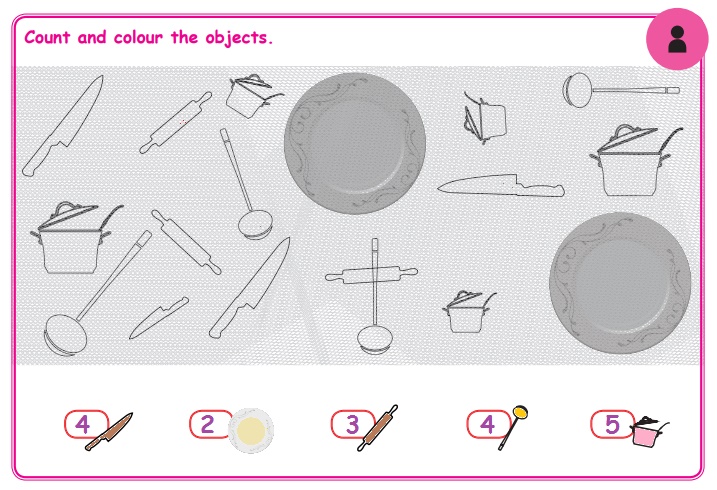
2. Medicine in the kitchen
In the past times, kitchen medicine was practiced in every house. Housewives knew how to treat some of the ailments of the family members and manage emergencies with what was available in the kitchen.
Is it not amazing to know that we have a pharmacy in our kitchen? Let us learn a few useful things we can use from the kitchen as medicines.
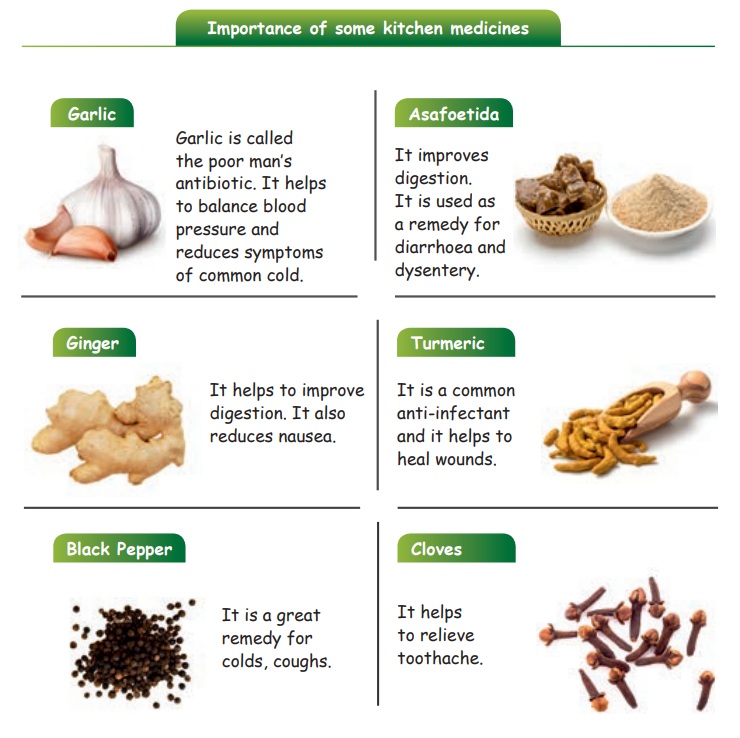
Importance of some kitchen medicines
Garlic
Garlic is called the poor man’s antibiotic. It helps to balance blood pressure and reduces symptoms of common cold.
Asafoetida
It improves digestion. It is used as a remedy for diarrhoea and dysentery.
Ginger
It helps to improve digestion. It also reduces nausea.
Black Pepper
It is a great remedy for colds, coughs.
Turmeric
It is a common anti-infectant and it helps to heal wounds.
Cloves
It helps to relieve toothache.
Try in your home
Coriander juice
This juice is made from the coriander leaves. It helps to reduce chest congestion. It is rich in iron and vitamins A, B and C.
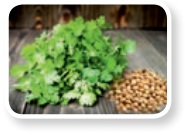
Preparation of coriander tea
This is made from coriander seed powder. One tablespoon of powder is mixed to two or three cups of water. Jaggery is added and they are boiled for 5 minutes. It improves digestion.

What are your favourite food items? Do you know the ingredients of them? Do they have any medicinal value? If so, fill in the table.
My favourite food: Gooseberry juice
Ingredients
Gooseberry
Ginger
Jaggery
Medicinal value
Vitamin C
Improves digestion
3. Simple Scientific investigations in Daily Life
The curiosity of science starts from home. It is promoted by simple scientific investigations of the things that the children see around them or use daily like, why the leaves are green in colour? What is the difference between the sun and the moon? How does the television work?
Shall we learn about few simple investigations?
1. Real and Shadow
For what ?
To learn how the shadows are formed.
How?
1. Make the classroom dark.
2. Light a candle.
3. Place a toy near the candle. What do you see?
4. Move the toy away from the candle. What do you see? Move the toy closer to the candle. What do you look at?
5. Experiment and see what happens to the shadow if the light source is dim?

Complete the sentence:
* Moving the toy closer to the candle made its shadow Short.
* While moving the object away made its shadow Long.
* The big candle is bright and gives dark, clear shadow.
* The small is dim and gives dim shadow.
Lava in a Cup
You will Need: A tall glass cup, 1/4 cup vegetable oil, 1 teaspoon salt, water, food colour.

What to do?
1. Fill the glass about 3/4 with water .
2. Add about 5 drops of food colour (Red).
3. Slowly pour the vegetable oil into the glass. See how the oil floats on top.
4. Sprinkle the salt on top of the oil.
5. Watch blobs of lava move up and down in your glass! Add another teaspoon of salt to keep the effect going.
What happens when you
add oil to water?
Oil floats in water.
add colour to the mix?
It becomes coloured.
add salt to the mix?
Coloured oil bubbles rises up and goes down.
First of all, the oil floats on the top of the water because it is lighter than the water. Since the salt is heavier than oil, it sinks down into the water and takes some oil with it, but when the salt dissolves, the oil goes up again. Is it not interesting?
4. Measuring Temperature of Water and Milk using Thermometer
* Have you seen this device?
* Where have you seen this?
* Do you know the use of thermometer?
Usually, our body temperature is lower in the morning; it increases during the day and is highest in the evening. Other than this, a rise in body temperature is usually caused by an infection. Using a thermometer to check our temperature can help us manage any illness.
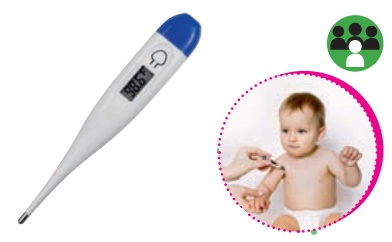
What is a thermometer?
Thermometer is an instrument used for measuring body temperature. It consists of a narrow, sealed glass tube, marked like a scale. The markings show the temperature.
Do you know: Daniel Fahrenheit, a German physicist, invented mercury thermometer in 1714.

Let us measure the boiling point of water using thermometer
Boiling point of water is 100°C
Things Needed : Water and thermometer
Procedure :
Heat the water. Measure the initial temperature, when the water starts to boil. Allow it to boil for few more minutes, measure the temperature.
The temperature remains the same when the boiling point reaches 100°C and continues to boil for some more time.

Similarly, the boiling point of milk can also be measured using thermometer.
Colour the thermometer to match the temperature written in the box.
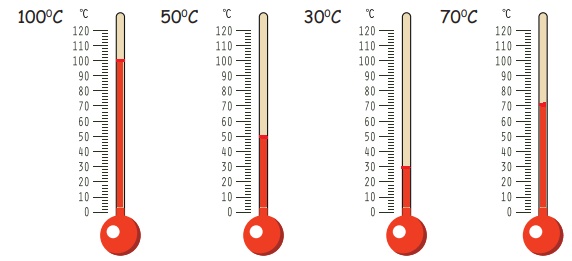
Related Topics